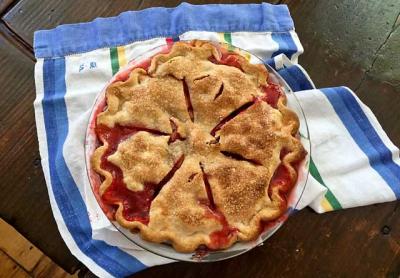Seasons by the Sea: Rhubarb: Love It or Hate It

I often wonder, who was the first person to taste rhubarb? Did they sample the big, beautiful, triangular leaves and die from an overdose of oxalic acid? Or did they reach down to the red, pink, and green edible stalks, slice off a piece, and declare it “tart, yet delicious. I think I can work with this.”
Rhubarb probably originated in China several thousands of years ago and was used for medicinal purposes. It reached Europe in the 14th century, was first planted in the U.S. around 1730, and was planted at Monticello by Thomas Jefferson in 1809 and 1811. He declared the leaves “excellent as spinach.” Well, HE survived!
In medieval times, transporting rhubarb across Asia was very expensive — it cost more than cinnamon, opium, and saffron. When the price of sugar came down, rhubarb became better known for culinary uses, in pies, compotes, wines, and savory dishes.
When you see rhubarb at a grocery store, it is most likely hothouse-grown, with big, thick stalks as wide as two inches. At farmsteads and farmers markets, you will find locally grown rhubarb with thinner stalks. The colors can range from bright red to hot pink to pale green. The flavor difference is not that discernible. Some people suggest using a vegetable peeler to remove the stringy exterior, but this isn’t always necessary. Once it is cooked, the strands melt away.
Rhubarb is technically a vegetable, but in 1947 the U.S. Customs court ruled that it is a fruit, either because that’s how it was most commonly used, or because taxation on it became lower.
According to Deborah Madison in her book “Vegetable Literacy,” “the roots and stems of rhubarb have been used as a curative herb to clean up after excesses of various kinds — culinary, sexual, and so forth.” Because of the toxicity of the leaves, they are also used in insecticides. The roots are an ingredient in bitters and are used in the inexplicably popular liqueur called Fernet-Branca. Ever tasted it? It is ghastly, but is widely regarded as an effective digestif. Prescribed by Dr. Marquis de Sade, maybe.
Rhubarb seems to be a polarizing vegetable/fruit. People either love it or hate it. I love it in all forms: by itself in a simple compote to serve with yogurt, ice cream, or really good ricotta cheese; especially good in a pie with strawberries, sweet, tart, pretty, and perfumy. When I started to think of more uses, I figured that any recipe that calls for tartness could use some rhubarb. So perhaps it could be used in lieu of tamarind paste in Indian recipes. Besides, who the heck has tamarind paste lying about the kitchen cupboard? How about chutneys and cocktails? Hot and sour soup? The possibilities are almost endless.
Besides being one of the first vegetables to appear in spring, rhubarb is inexpensive and can last in your refrigerator for a few weeks. It is easy to freeze as well. Simply wash, dry, and chop. Place on a sheet pan and freeze. From there, just put the chunks into Ziploc bags and pull out as needed.
Some of the many compatible flavors are berries, apples, ginger, cardamom, almond, vanilla, citrus, and cinnamon. A rhubarb chutney would be good on white fish like sword, striped bass, fluke, or flounder. You can make a tangy barbecue sauce for pork and chicken. Rhubarb is good in muffins, cakes, galettes, and custards. It can also be an ingredient in, or sauce for, ice creams, sorbets, and souffles. Some countries serve the stem raw, sprinkled with salt and chili pepper. In Scandinavia, it is eaten raw as a snack, dipped in sugar.
I made a strawberry-rhubarb pie the other day and tried orange zest and one teaspoon of vanilla extract as flavor enhancers. It was delicious but too juicy, so the bottom of my oven now has a layer of hardened sugar napalm.
It’s a matter of taste, but most recipes call for two-thirds rhubarb to one-third strawberries, or half and half of each. It is hard to predict how much thickener you will need, and it also depends on whether you want the filling clear or don’t mind it a bit cloudy. For clear, use cornstarch, approximately a quarter-cup per six cups of fruit, enough for one eight or nine-inch pie. You will also need to use one to one-and-a-half cups of sugar. I used one cup and it was TART, but I like it that way. If you don’t mind a cloudier filling, use one-third to one-half a cup of flour.
You should also be aware that if your rhubarb is mostly green, it will turn a muddy, tan-green when cooked, so keep that in mind if color is important in your recipe.
Strawberries are already coming in on the North Fork and should be available locally within the next few weeks. They are a match nonpareil with rhubarb in spring, like morels and asparagus, or peas and mint.
Rhubarb is one of our first fresh garden gifts. Give it a try in some classic recipes and a few with a modern twist.
Click for recipes
